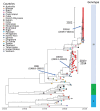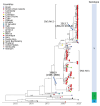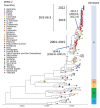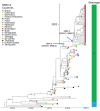Introduction of New Dengue Virus Lineages of Multiple Serotypes after COVID-19 Pandemic, Nicaragua, 2022
- PMID: 38782023
- PMCID: PMC11138998
- DOI: 10.3201/eid3006.231553
Introduction of New Dengue Virus Lineages of Multiple Serotypes after COVID-19 Pandemic, Nicaragua, 2022
Abstract
Major dengue epidemics throughout Nicaragua's history have been dominated by 1 of 4 dengue virus serotypes (DENV-1-4). To examine serotypes during the dengue epidemic in Nicaragua in 2022, we performed real-time genomic surveillance in-country and documented cocirculation of all 4 serotypes. We observed a shift toward co-dominance of DENV-1 and DENV-4 over previously dominant DENV-2. By analyzing 135 new full-length DENV sequences, we found that introductions underlay the resurgence: DENV-1 clustered with viruses from Ecuador in 2014 rather than those previously seen in Nicaragua; DENV-3, which last circulated locally in 2014, grouped instead with Southeast Asia strains expanding into Florida and Cuba in 2022; and new DENV-4 strains clustered within a South America lineage spreading to Florida in 2022. In contrast, DENV-2 persisted from the formerly dominant Nicaragua clade. We posit that the resurgence emerged from travel after the COVID-19 pandemic and that the resultant intensifying hyperendemicity could affect future dengue immunity and severity.
Keywords: Nicaragua; dengue; dengue virus; genome; neglected disease; parasites; serotypes; vector-borne infections; viruses.
Figures





References
-
- World Health Organization. Dengue and severe dengue [cited 2023 Oct 11]. https://www.who.int/news-room/fact-sheets/detail/dengue-and-severe-dengue

